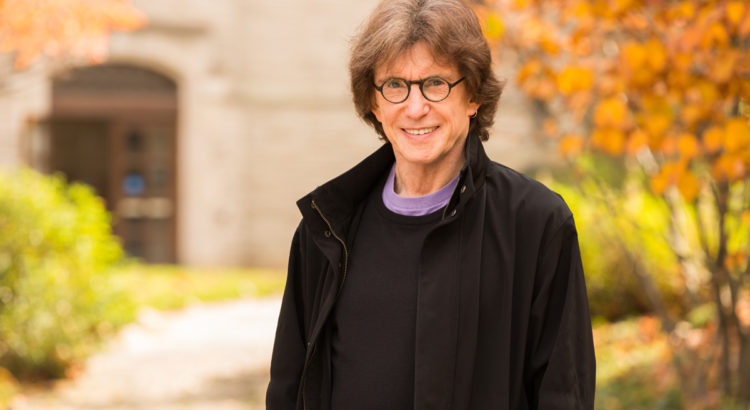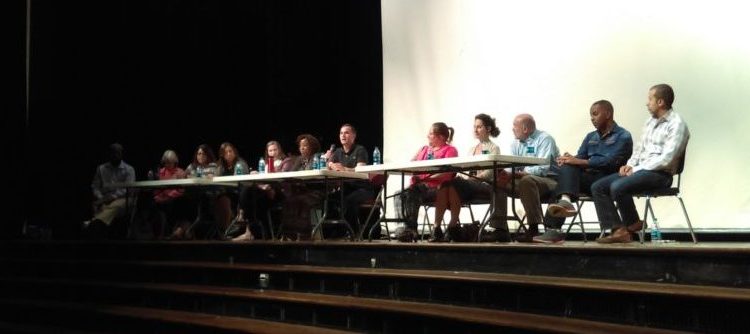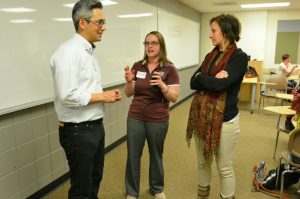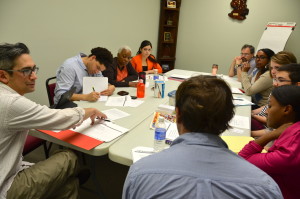América del Norte/EE.UU./28 de octubre de 2016/www.herramienta.com.ar
McLaren, Peter. Es uno de los principales representantes de la pedagogía crítica revolucionaria. Nació en Toronto, Canadá en 1948. En 1973 obtuvo el título de “Bachelor of Arts” en Literatura Inglesa en la Universidad de Waterloo; después se recibió de “Bachelor of Education” en la Facultad de Educación de la Universidad de Toronto. Realizó una maestría en Educación en Brock University y un doctorado en el “Institute for Studies in Education” (Instituto de Estudios en Educación), en Ohio, Universidad de Toronto). Dejó Canadá en 1985 para dar clases en la “School of Education and Allied Professions” (Escuela de Educación y Profesiones Afines), en la Universidad de Miami, Ohio, donde trabajó durante ocho años con su colega Henry Giroux; durante este tiempo, participó de los inicios de la Pedagogía Crítica en EE.UU. McLaren también fue Director del “Center for Education and Cultural Studies” (Centro de Educación y Estudios Culturales) de la misma Universidad, antes de ser contratado por la “Graduate School of Education and Information Studies” (Escuela de Graduados en Educación y Estudios sobre Información) de la Universidad de California en Los Ángeles. Entre sus libros más importantes traducidos al castellano figuran: Pedagogía crítica y cultura depredadora (1995). Políticas de oposición en la era posmoderna”; La escuela como un performance ritual. Hacia una economía política de los símbolos y los gestos educativos (1986); La vida en las escuelas. Una introducción a la pedagogía crítica en los fundamentos de la educación (1986); Multiculturalismo revolucionario. Pedagogías de disensión para el nuevo milenio (1997); El Che Guevara, Paulo Freire y la pedagogía de la revolución (1999). ). mclaren@gseis.ucla.edu Colaborador de la revista Herramienta. En 2012 publicamos La pedagogía crítica revolucionaria. El socialismo y los desafíos actuales.
Por Samuel Day Fassbinder
SDF: Peter, dile a los lectores de esta entrevista una breve síntesis de cuáles fueron tus proyectos pasados más importantes, y cuál es tu proyecto más importante hoy.
Peter: Mi trabajo es en el área de la pedagogía crítica revolucionaria. Esto, en pocas palabras, implica enseñar con el propósito de crear una alternativa democrática socialista a una sociedad gobernada por la forma valor del trabajo, o la venta de la propia fuerza de trabajo por un salario. Cuando el apetito corporativo revela una tan despiadada insaciabilidad, deleitándose en su propia autoridad desenfrenada como un rey del Medioevo cuyo poder no tiene límites, sabemos que estamos en problemas.
Al mercado no le afecta en absoluto nuestra necesidad de estructurar nuestra humanidad. No hay ningún motivo para que los seres humanos deban soportar la servidumbre por deudas. No tenemos necesidad de vivir en condiciones que Chris Hedges llama la “repetición de la esclavitud” o la “servidumbre no pagada” – regalos a los pobres no sólo de parte de los oligarcas de las corporaciones sino del propio capital. Cuando la miseria humana pasa a ser un acuerdo comercial cerrado con un brindis y un costoso cigarro Davidoff y con la obscenidad de un costoso coctel Martini en el Ritz-Carlton Tokyo, entonces sabemos hacia dónde vamos y que va a ser desolador, en el mejor de los casos, para quienes sobrevivan.
A todos aquellos buenos cristianos que creen que la Biblia ha dado a la humanidad la autoridad para usar la naturaleza como le plazca, les diría que Jesús no deseaba que sus seguidores fueran bautizados en las aguas residuales y tóxicas de estanques de contención de las perforaciones en los yacimientos. No se suponía que en las frentes de los creyentes un Miércoles de Ceniza se utilizaría la ceniza del carbón de los embalses mineros. Como educador, creo que es mi deber promover un programa socialista, y no me disculparé por eso.
SDF: Entonces, ¿qué te trajo a esta conferencia en particular, en Turquía?
Peter: Era uno de los conferenciantes en la 3ra. Conferencia anual sobre educación crítica titulada “La educación bajo la amenaza del Neoliberalismo y el Neoconservadurismo” y tuvo lugar en Ankara, Turquía.
SDF: ¿Con quiénes estuviste en Turquía y qué hiciste con ellos?
Peter: Durante un intervalo en la conferencia en la Universidad de Ankara, oí que algunos estudiantes estaban protestando sobre la censura de los medios alrededor de dos ataques con bombas en la ciudad fronteriza de Reyhanli que mataron a 51 personas el sábado (11 de Mayo). Escuché que fueron atacados con gas lacrimógeno y quería mostrarles mi apoyo, así que los seguí unas cuadras pero dado que me estoy recuperando de una operación de rodilla y caminando mayormente con muletas, tuve que volver al campus antes que llegaran los manifestantes a su destino. Luego, varios días después, Dave Hill, un profesor de educación de Londres y yo estábamos en el centro de la ciudad y oímos sobre una manifestación similar y nos sumamos para apoyar a los manifestantes. La policía disparó gas lacrimógeno hacia la multitud y me golpearon, y gracias a la ayuda de un mozo de un restaurant cercano, me llevaron allí y me escondieron en un cuarto trasero.
SDF: ¿Qué sensación de logro te llevaste de la conferencia en Turquía?
Peter: Fue alentador estar con educadores de Turquía y Grecia que trabajaban juntos en una atmósfera de solidaridad y respeto mutuo. Había un apego entre los dos grupos que se fortalecía a medida que la conferencia progresaba. Los presentadores y la audiencia eran de todo el mundo, y ver tantos educadores críticos acordar sobre tantas plataformas políticas fue motivador. Los análisis de neoliberalismo eran sofisticados y había un acuerdo general de que era urgentemente necesaria una alternativa socialista al capitalismo. La camaradería era fuerte, y la conferencia carecía de demagogia o de prima donnas. Había un fuerte énfasis en la lucha de clases en su mayor parte desprovisto de las distinciones de las políticas identitarias. Cuando se discutía sobre la raza y el género y la discapacidad y el patriarcado y la sexualidad, era dentro de la más amplia óptica del capitalismo neoliberal y de una búsqueda de alternativas.
Durante veinte años, he tenido la oportunidad de encontrarme y trabajar con educadores de una variedad de movimientos sociales, incluido el movimiento de shack-dwellers (habitantes de viviendas muy precarias), el Abahlali baseMjondol, el movimiento de trabajadores sin tierra, Movimento dos Trabalhadores Rurais Sem Terra-MST, en Brasil, los Zapatistas en México, y miembros de la Revolución Bolivariana en Venezuela. Pero la mayoría de mi trabajo ha sido con escuelas de educación y sindicatos docentes a lo largo de América Latina. La conferencia en Turquía me introdujo a un nuevo conjunto de compañeros trabajando en contextos muy difíciles, y contra un orden social muy represivo.
SDF: Ahora me gustaría cambiar el tema de esta entrevista un poco, y centrarnos sobre la búsqueda de alternativas al capitalismo, ahora, en la era neoliberal. Mi amigo Jason W. Moore, que recientemente promovido a profesor en la Universidad de Binghamton en el Estado de Nueva York, discute sobre la forma en que el sistema mundial capitalista parece acercarse a un estado de “máxima acumulación”. Podemos, entonces, esperar ver una multiplicación de crisis, económicamente, socialmente y en términos de recursos. ¿Cómo ves que esto afectará al activismo en el futuro, y cómo continúa la lucha de clases a la luz de “la máxima acumulación”?
Peter: Como sabes, mi trabajo ha sido brindar un análisis marxista al sistema del capitalismo global, y examinar los esfuerzos de reforma educativa desde esta perspectiva. La mayoría de los educadores críticos en los Estados Unidos son seguramente liberales de izquierda y aunque tienen sofisticados análisis del capitalismo neoliberal, no consideran seriamente las alternativas socialistas al capitalismo.
Aquellos que sí llegan a sus conclusiones no lo hacen necesariamente a través de Marx sino a través de análisis eco-pedagógicos como los que ofreces tú, Sam, o gente como Richard Kahn, David Greenwood y Tina Evans, para nombrar algunos pocos de los mayores exponentes que tratan a la educación en particular. Yo comencé con un análisis económico. Consideré comentarios del economista liberal Robert Reich, quien discute (2013) que “a medida que el capital global se vuelve más poderoso, las corporaciones gigantes extorsionan a los gobiernos y a los ciudadanos para pedir rescate– obteniendo subsidios y exenciones impositivas de gobiernos preocupados por la “competitividad” de sus naciones – mientras refugian sus ganancias en las jurisdicciones con los menores impuestos que puedan encontrar.”. Él señala, con razón, que “Google, Amazon, Starbucks, cualquier otra gran corporación, y cada gran banco de Wall Street están resguardando tanto como pueden muchas de sus ganancias en Estados Unidos en el extranjero, mientras le dicen a Washington que se necesita imponer menores impuestos corporativos para mantener a los Estados Unidos ‘competitivo’”. Esto es cierto, por supuesto, como lo es el incalculable sufrimiento humano que resulta de los efectos pauperizantes y las movilizaciones descendentes como resultado del capitalismo global.
También es cierto, de acuerdo con Reich, que “las corporaciones globales no tienen lealtad hacia ningún país; su único objetivo es hacer la mayor cantidad de dinero posible – y contraponer un país contra otro para mantener sus impuestos bajos y subsidios altos, de ese modo trasladar la presión impositiva a la gente común cuyos salarios ya están hundiéndose porque las compañías están enfrentando a los trabajadores entre sí.” Esto es lo que el sociologo marxista, William I. Robinson (2012) describiría como una economía conducida por la “acumulación militarizada”, la “especulación financiera salvaje”, y el “saqueo de las finanzas públicas para sostener la obtención de ganancias frente a la sobre-acumulación.” Él escribe en forma pavorosa que la clase capitalista transnacional “ha descargado miles de millones de dólares en la especulación en el mercado inmobiliario, los alimentos, la energía y otros mercados globales de materias primas, en los mercados de bonos de todo el mundo (esto es, presupuestos públicos y finanzas estatales), y en cada “derivado” imaginable, desde fondos de cobertura hasta swaps, mercados de futuros, obligaciones de deuda colateralizadas, pirámides de activos, y esquemas de Ponzi” (2011a ). Esto llevó directamente, como sabemos, al colapso del sistema financiero global de 2008.
Ahora, el problema con estas perspectivas liberales es que no enfrentan al capitalismo global como una crisis sistémica. El filósofo humanista marxista Peter Hudis afirma este punto enérgicamente cuando discute sobre la economía de Estados Unidos, la crisis en la Eurozona, y la desaceleración del crecimiento en países como China, India y Brasil. Hudis argumenta que la emisión de billones de dólares en rescates a Bancos y programas de estímulo económico no hizo mucho para revertir la crisis sistémica/estructural. Muchos de los denominados expertos pensaron que la crisis hipotecaria y el colapso del sistema financiero global en 2008 era el resultado de una recesión cíclica que podía ser resuelta a través de salvatajes y paquetes de estímulo estatales. Entonces, estamos frente a una perspectiva de medidas de austeridad como un supuesto antídoto a la crisis (que algunos expertos especulan que puede durar cuatro o cinco décadas). Hudis sostiene que la ineptitud política y la codicia corporativa de una pequeña camarilla de ricos oligarcas no es la causa de la actual crisis económica sino el resultado de la misma – las acciones atroces de banqueros y los enlodados dueños de los fondos de cobertura están enraizadas en la crisis del capital mismo y no pueden ser reducidas a rasgos humanos como la codicia y la avaricia (aunque no se pueden descartar totalmente aquellas características humanas). Las medidas de estímulo keynesiano ya no son suficientes para resolver la profunda crisis estructural que subyace al casi colapso de la economía en 2008 –que Hudis describe como “la declinación en la tasa de ganancia que ha plagado al capital global durante décadas.”
William I. Robinson explica el panorama más amplio mejor que la mayoría. Describe las crisis económicas cíclicas como “episodios en curso en el sistema capitalista, que se producen alrededor de una vez por década y habitualmente duran entre 18 meses y dos años” (2011). Y compara esta crisis con crisis estructurales que “son más profundas; su resolución requiere una restructuración fundamental del sistema”. También describe las crisis estructurales mundiales previas, durante las décadas de 1890, 1930 y 1970, crisis que fueron resueltas “a través de la reorganización del sistema que produjo nuevos modelos de capitalismo” que pudo superar los límites del capitalismo, conduciendo a una reanudación de la acumulación del capital a escala global. Robinson sostiene que la crisis de 1890 “se resolvió en los centros del capitalismo mundial a través de la exportación de capital y una nueva ronda de expansión imperialista”. Señala que la Gran Depresión de la década de 1930 “se resolvió a través de la vuelta a variantes de la socialdemocracia tanto en el Norte como en el Sur – el capitalismo del estado de bienestar, populista o desarrollista que incluyó la redistribución, la creación de sectores públicos y la regulación estatal del mercado.” Para entender la crisis del capital en la coyuntura actual, a la que podríamos llamar “la etapa de globalización del capitalismo mundial”, debemos examinarlo en relación a episodios anteriores de crisis, en particular la crisis de la socialdemocracia de 1970, o a lo que Robinson se refiere como la era del “fordismo-keynesianismo”, o “capitalismo redistributivo”.
Necesitamos comprender el surgimiento de “una fase transnacional o global cualitativamente nueva del capitalismo mundial que puede remontarse hacia la década de 1970, y se caracteriza por el surgimiento de un verdadero capital transnacional y una clase capitalista transnacional” (2011a) que vino cuando la expansión capitalista se hizo global a través de maquinaciones del neoliberalismo y, como resultado, la clase capitalista transnacional pudo capturar el poder del estado en la mayoría de los países durante las décadas de 1980 y 1990. Aquí, de acuerdo con Robinson, las elites orientadas globalmente o la “clase capitalista transnacional” se liberó de las limitaciones del estado-nación a la acumulación y han reconstituido su poder de clase. Los avances en la computación y la tecnología de la información ayudaron a la clase capitalista transnacional “a alcanzar importantes conquistas en la productividad y a reestructurar, “flexibilizar”, y mudar el trabajo por todo el mundo” (2011). El resultado fue “una enorme expansión extensiva e intensiva del sistema y desató una frenética nueva ronda de acumulación global que contrarrestó la crisis de la década de 1970 de declive de las ganancias y las oportunidades de inversión.”
Noté el efectos sobre la educación de lo que Robinson (201 a) denomina como “hiper-acumulación a través de las nuevas tecnologías como las computadoras y la informática, a través de políticas neoliberales, y a través de nuevas modalidades de movilización y explotación de la fuerza de trabajo global – incluyendo una masiva nueva ronda de acumulación originaria, desarraigando y desplazando a cientos de millones de personas – especialmente en los campos del tercer mundo, que se han vuelto migrantes internos y transnacionales.” Encontré este estilo militarizado de acumulación global de capital en la educación cuando vine por primera vez a Estados Unidos desde Canadá, trabajando con Henry Giroux. Estábamos luchando para crear lo que llamamos una pedagogía crítica cuyo objetivo era crear una ciudadanía críticamente informada – ciudadanos críticos que pudieran desarrollar una conciencia crítica capaz de cuestionar a las relaciones hegemónicas dominantes en la economía, el estado, la producción cultural, la ley, los derechos civiles, etc. Pero esto era cuando las corporaciones estaban ganando más poder que los estados nación en muchas áreas – de modo que a la educación la estaban vendiendo a los gerentes de los fondos de cobertura, y especuladores, banqueros y empresarios y se la estaba transformando en un subsector de la economía y al énfasis se lo ponía en crear ciudadanos consumidores, no ciudadanos críticos.
Aquí es cómo lo explica la teoría. El capital quiere reducir su dependencia sobre trabajo vivo y exprimirle más valor al trabajo – pero teme una revolución social por parte de quienes están más devastados por el sistema capitalista. El capitalismo, como nos lo recuerda Hudis, es continuamente impulsado a reducir la proporción de trabajo vivo respecto al trabajo muerto (o capital), con el tiempo el capital ataca hasta el sobre-empleo relativo de trabajadores no productivos y esto lo vemos hoy “en el esfuerzo concertado de numerosas facciones de capital global para reducir el número como así también los salarios y beneficios de trabajadores de servicios públicos, especialmente a través de las medidas de austeridad”. Las luchas sociales y de clases mundiales que pudieron en el siglo XX imponer una medida de control social sobre el capital no necesariamente van a trabajar del mismo modo; a diferencia del pasado, no pueden, como señala Robinson, “forzar el sistema para vincular lo que llamamos la reproducción social con la acumulación del capital” (2011). Es la “separación de la lógica de acumulación de la lógica de la reproducción social” que hoy da como resultado “un crecimiento sin precedentes de la desigualdad social y las crisis intensificadas de la supervivencia para miles de millones de personas en todo el mundo.”
Robinson identifica “el problema crónico de la sobre-acumulación” o la incapacidad de los capitalistas transnacionales “para descargar su masa sobredimensionada y en expansión de los excedentes- no pueden encontrar canales donde invertir su dinero para así generar nuevas ganancias; por lo tanto el sistema entra en recesión o peor”. La clase capitalista transnacional está utilizando la actual crisis en el capitalismo global para desmantelar brutalmente lo que queda del estado de bienestar. Robinson sostiene que el sistema se está hundiendo más profundamente en el caos y la clase capitalista transnacional no puede administrar las contradicciones en el sistema pero, sin embargo, ha adquirido un enorme poder transnacional y control sobre recursos globales e instituciones.
Podemos derrotar al capitalismo neoliberal, pero el resultado sería una nueva reestructuración que lleve a algún modelo diferente de capitalismo mundial – lo que Robinson retóricamente señala que podría ser un nuevo orden capitalista reformado, “un keynesianismo global que implique la redistribución transnacional y la regulación transnacional del capital financiero.” O, como afirma Robinson, podríamos estar orientados hacia una crisis sistémica que demanda una destrucción completa del sistema mismo y la creación de un sistema completamente nuevo. Que una crisis estructural se vuelva o no sistémica depende, advierte él mismo, “de cómo respondan las distintas fuerzas sociales y de clase a los proyectos políticos que propongan como así también a los factores contingentes que no se pueden predecir, y a las condiciones objetivas.” De manera que no podemos decir en esta coyuntura actual histórica cuáles serían esas respuestas. No sabemos el desenlace. Lo que sí sabemos, de acuerdo con Robinson, es que el sistema hoy tiene ciertas características peculiares que las crisis de las décadas de 1930 y 1970 no tenían; primero, el sistema “está rápidamente alcanzando los limites ecológicos de su reproducción.” Segundo, “la magnitud de los medios de violencia y control social no tiene precedentes” y aquí el autor se refiere a las “guerras computarizadas, drones, bombas rompe-bunker, guerra de las galaxia, etcétera.” Y tercero, ahora hay una “concentración del control sobre los medios de comunicación de masas, la producción de símbolos, imágenes y mensajes en las manos del capital transnacional” sin precedentes. Y cuarto, sabemos en forma inequívoca que “estamos alcanzando los límites de la expansión extensiva del capitalismo, en el sentido de que ya no hay más territorios nuevos de importancia que puedan ser integrados al capitalismo mundial.” Y agrega: “La des-ruralización está ahora muy avanzada y la mercantilización del campo y de los espacios pre-capitalistas y no capitalistas se ha intensificado, esto es, se han convertido al estilo de invernaderos en espacios del capital, de modo que la expansión intensiva está alcanzando profundidades jamás vistas antes.” Y quinto, hay “un aumento de la vasta población excedente que habita un planeta de barriadas miserables, ajeno a la economía productiva, arrojado hacia los márgenes, y sometido a sofisticados sistemas de control social y a crisis de supervivencia – a una crisis mortal de desposesión-explotación-exclusión.” Aquí, Robinson eleva el espectro de “un fascismo del siglo XXI y nuevos episodios de genocidio para contener la masa de humanidad excedente y a su rebelión real o potencial.” Ahora otros han dicho lo que Robinson había dicho, pero lo que creo que es distintivo en el análisis de Robinson es que hace hincapié en el importante hecho que los aparatos estatales transnacionales ya no pueden jugar el rol hegemónico que alguna vez jugaron, esto es, ya no pueden controlar o estabilizar el sistema capitalista como lo hicieron durante la etapa del capitalismo global fordista/keynesiana y por eso hoy los estados nación tienden a perder su legitimidad política, y asistimos, por ejemplo, a lo que está pasando hoy en día en Grecia, o en España, o en países que ahora se separan como resultado de las brutales medidas de austeridad impuestas por el Fondo Monetario Internacional.
Robinson identifica tres sectores del capital transnacional que “se destacan como los más agresivos y propensos a buscar acuerdos políticos neo-fascistas para forzar la expansión de la acumulación mientras esta crisis continúa: capital financiero especulativo, el complejo militar-industrial-seguridad, y el sector extractivo y energético.” ¿Qué pasa con la acumulación de capital en el complejo militar-industrial-seguridad? Bien, eso “depende de conflictos y guerras sin fin, incluyendo las denominadas guerras contra el terrorismo o las drogas, así como también de la militarización del control social.” Robinson revela en forma inquietante que en los Estados Unidos, “el complejo penitenciario privado para inmigrantes es una industria en plena expansión. Los inmigrantes indocumentados constituyen el sector que más rápido crece de la población carcelaria en el país y están detenidos en centros de detención privada y deportados por compañías privadas contratadas por el estado norteamericano” (2011a). ¿Qué pasa con el capital financiero transnacional? Bueno, eso “depende de tomar el control de las finanzas estatales y de imponer deudas y austeridad en las masas, lo que a su vez sólo se puede lograr a través de una escalada de la represión” (2011). ¿Y qué pasa con las industrias extractivistas? Eso se lo puede entender mejor en términos de “nuevos rondas de desposesión violenta y degradación ambiental por todo el mundo.” Ahora estamos siendo testigos de una revuelta global.
He estado en Occupy Los Angeles, he visitado la comunidad de Cherán en México que está rompiendo con el estado Mexicano y formando su propia milicia, he pasado tiempo trabajando para los chavistas en Venezuela, y acabo de regresar de las protestas en Turquía. Sí, hay revuelta en todas partes, es verdaderamente global. Necesitamos, evidentemente, una coordinación transnacional de resistencia contra la represión masiva coordinada transnacionalmente, y vemos alrededor nuestro los esfuerzos de la clase capitalista transnacional para destruir sindicatos, debilitar a los trabajadores, apuntar a los intelectuales, y destruir todo lo que quede de lo que pudo haberse llamado una esfera pública. Esta es la razón por la cual Chávez intentó construir un bloque regional contra el intento de los Estados Unidos de volver a alinear a Latinoamérica luego de la elección de líderes de izquierda. Coincido con Robinson en que necesitamos una “redistribución masiva de riqueza y poder descendiendo hacia la mayoría pobre de la humanidad sobre las líneas de un socialismo democrático del siglo XXI en el que la humanidad no esté más en guerra con ella misma ni con la naturaleza.” Sobre esto se ha tratado mi trabajo en la pedagogía crítica revolucionaria; ayudar a crear un socialismo democrático a través de la educación, a través del proyecto de la pedagogía crítica tal como la desarrollé a partir de mi mentor, Paulo Freire.
Ahora Robinson ataca con razón sobre Obama,y me gusta mucho su análisis gramsciano sobre cómo está buscando Obama restablecer la hegemonía que se perdió durante la resistencia a la administración de Bush Jr., mediante la institución de una revolución blanda, diseñada para debilitar los cuestionamientos masivos de parte de la izquierda más militante. Desafía al estado a nivel cultural e ideológico, impulsando los derechos de los inmigrantes, y los derechos de los gays, etcétera (que, por supuesto son buenas políticas en sí mismas) y otras “cuestiones morales” hasta cierto punto pero al mismo tiempo se asegura que el orden socio-económico jamás sea cuestionado o desafiado en sus fundamentos; y en caso que fuera desafiado ha creado una masiva seguridad estatal para reprimir cualquier desafío real al matrimonio entre el dominio corporativo y el poder estatal. Esto cubre la barbarie sistémica del capitalismo bajo la pantalla de humo de la codicia corporativa como una fragilidad humana. Esta revolución blanda es lo que Gramsci denomina una “revolución pasiva” contra la resistencia popular – y está triunfando a través de su habilidad para cooptar a líderes de los niveles bajos. Robinson afirma que las fuerzas dominantes en Egipto, Túnez, y otros lugares en el Medio Oriente y Norte América se están moviendo en la dirección de una revolución pasiva. La administración de Obama ha sido brillante al canalizar a la resistencia popular en una revuelta pasiva, despojando su poder y debilitando a las formas más activas de insurgencia por parte de sindicatos, socialistas y ambientalistas militantes. Lo que le preocupa a Robinson es lo que me preocupa a mí; y eso es la consolidación de una base social que consiste en una amplia franja de trabajadores blancos excluidos que históricamente disfrutaban lo que Robinson describe como “privilegio racial de casta” durante la época anterior del fordismo-keynesianismo del capitalismo nacional. Quienes están atrapados en un “circuito mortal de acumulación-explotación-exclusión” son simplemente abandonados, aislados, criminalizados y reprimidos al interior del trabajo excedente, o super-explotado.
Evidentemente, hoy en día, sea que elijamos denominar al trabajo tecno-científico “inmaterial” o no, está claro que la lucha ya no es entre hombres en mameluco contra los propietarios de las fábricas con sombreros de copa, corbatas y chalecos cruzados. O los “sans-culottes” contra los vestidos con calzones de la clase dominante. O trabajadores en botas de cuero con punteras de acero y cinturones porta- herramientas colgadas de las caderas. O financistas con capas y bastones con puntas de plata explotando la fuerza de trabajo de fruteros, zapateros y mineros del cobre cargando alforjas con sueños perdidos. Tenemos “trabajadores de conocimientos” y “trabajadores de servicios” y “trabajadores de talleres clandestinos”, todos ellos pueden jugar un rol en la lucha venidera. La lucha es la clase capitalista transnacional contra todos aquellos que dependen de su salario por su trabajo.
SDF: Jason W. Moore discute cómo el sistema capitalista mundial aparece acercándose al estado de “máxima acumulación”. Podemos, entonces, esperar ver una multiplicación de crisis económicas, sociales y en términos de recursos. ¿Cómo ves que esto afecte el activismo en el futuro?
Peter: Una dimensión de mi trabajo que es relativamente nueva trabaja con los problemas actuales de la crisis ecológica. Aquí he recibido la influencia de las obras de Joel Kovel, John Bellamy Foster, y Jason W. Moore, en particular.
Mi posición es que las consecuencias de la emergencia simultánea de formas transnacionales del capitalismo basadas en la explotación del trabajo humano y la crisis endémica del capitalismo – basada en los conflictos políticos y de clase que toman lugar dadas las relaciones de producción explotadoras- es también los orígenes de la actual crisis ecológica. De la misma forma que la explotación del trabajo humano sustenta las condiciones de posibilidad de todos los otros antagonismos, incluyendo odios raciales profundos y globalizados, que no es reducirlos todos a formas transnacionales y de clase del capitalismo actual y sus precedentes históricos son precondiciones para el ecocidio.
Jason Moore ha sido útil en este tema, quien argumenta no sólo que “el capital externaliza la naturaleza a través de la apropiación de la naturaleza extra-humana como “regalo gratuito (Marx 1967 III:745), sino también afirma que los regalos gratuitos de la naturaleza no se “limitan a los minerales, el suelo, etcétera.: también incluye a la fuerza de trabajo humana (re)producido fuera del circuito del capital” (Marx 1967:377). De este modo el capital explota tanto a la sociedad como a la naturaleza en el sentido asignado a su explotación de la naturaleza como tal.
Al discutir la obra de William I. Robinson (en Capitalists and Conquerors), identifico “el problema crónico de la sobre-acumulación” o la incapacidad de los capitalistas transnacionales “para descargar sus excesiva y expansiva masa de excedentes – no pueden encontrar puntos de venta para invertir su dinero con el fin de generar nuevas ganancias; por lo tanto el sistema entra en recesión, o peor”. En otras palabras, se producen más mercancías que las que pueden comprar los clientes.
Pero también quiero discutir lo que Jason W. Moore describe como una crisis de sub- producción, que la toma directamente de Marx. En la subproducción, a la que Marx se refería como una ley general de la acumulación que trabaja al mismo tiempo que la sobreproducción, el capital es forzado a sustituir crecientes cantidades de capital y trabajo por la desaparición de aspectos de naturaleza que Marx refiere como “regalos gratuitos”, que se refiere tanto a la naturaleza externa (el medio ambiente) y la naturaleza interna (las tendencias humanas). En la época del capitalismo tardío, ambas naturalezas han sido configuradas para contribuir al proceso de acumulación del capital. El capitalismo se apropia de los regalos gratuitos de la naturaleza por fuera del sistema de la producción mercantil para maximizar la productividad laboral.
Hay muchas relaciones no-mercantilizadas que han sido agotadas para posibilitar la acumulación del capital. Después de todo, la naturaleza se la debe reconfigurar en particular para permitir el auge del capitalismo mismo – y Moore señala que fue a partir de la reconfiguración peculiar de la naturaleza que se priorizó la productividad del trabajo sobre la productividad de la tierra. Esto condujo a la dialéctica del saqueo y productividad que está en el centro de la acumulación capitalista contemporánea. Esto es importante comprender al capitalismo como una ecología global, y que el capitalismo es una forma de organizar la naturaleza.
El reordenamiento de las naturalezas humanas y extrahumanas en regímenes ecológicos específicos ocurre hoy en día a través de la financialización, la creación de nuevos órdenes raciales, el surgimiento y la reproducción de regímenes coloniales así como también la reproducción de la colonialidad del poder. Hay, en verdad, resistencias populares contra todo lo mencionado previamente. Todas las crisis económicas son crisis ecológicas, todas las revoluciones son revoluciones ecológicas, todas las pedagogías críticas son eco-pedagógicas. Ahora Robinson afirma que las luchas populares podrían conducir a un nuevo orden capitalista reformado, “un Keynesianismo global que incluye una redistribución transnacional y una regulación transnacional del capital financiero”. O, tal vez, hacia una crisis sistémica que demanda una destrucción completa del sistema mismo y la creación de un sistema enteramente nuevo –lo que podríamos llamar un socialismo para el siglo XXI, haciendo eco de una frase común usada en Venezuela para describir la revolución bolivariana instituida por Chávez.
Usando términos de Jason W. Moore, nos enfrentaríamos con una “crisis de desarrollo”, en la que el capitalismo se transforma para superar esa crisis, a través de innovación tecnológica y expandiendo la acumulación de capital, o una “crisis de época”, que refiere al fin de una forma de vida económica y el comienzo de otra – como por ejemplo el movimiento del feudalismo al capitalismo o del post-fordismo/keynesianismo de la década de 1970 al capitalismo financiero que marca la era del neoliberalismo. Todo esto depende de cómo respondan las distintas fuerzas sociales y de clase a estas crisis. Es decir, depende de nosotros. Y hasta qué punto deseamos convertirnos en agentes activos y protagónicos de la transformación histórica; en hacedores de la historia en lugar de productos pasivos de la historia. Por supuesto, siempre somos ambas cosas, dialécticamente hablando.
Pero necesitamos inclinar el fiel de la balanza y reclamar nuestro acción protagónica porque aunque siempre seremos tanto productores como productos, necesitamos reclamar nuestro derecho a elegir sobre lo que producimos, y cómo, y bajo los intereses de quién y con qué propósito. De otra manera podríamos también elegir no no existir en absoluto, que es lo que muchos de nosotros, cansados, golpeados, despreciados y olvidados, ya hemos hecho, con el pretexto de adaptarnos en un sistema que sabemos implacablemente bárbaro, moralmente esquizofrénico, salvajemente abusivo, cruelmente represivo, egoístamente despiadado, y mordazmente destructivo.
SDF:¿Podrías decir algo sobre las protestas que se están llevando a cabo en Turquía?
Peter: Uno de mis amigos, un profesor en la Universidad de Ankara, me envió una nota justo antes de la participación en una demostración, y me dijo que las manifestaciones eran contra “el terror policial y el poder gobernante pro-Americano y pro Unión Europea del país (AKP)”. Los manifestantes “quieren que el gobierno AKP/Erdogan renuncie”. En un sentido más amplio, se oponen a “las políticas neo-liberales y neoconservadoras del poder gobernante de Turquía” que han provocado un “crecimiento dramático de la pobreza, el desempleo, el hambre, la injusta redistribución de la riqueza, la migración, etc”. El segundo problema es el “espectáculo unipersonal de Erdogan, que es en realidad un líder fascista-religioso al que Occidente muestra como un buen modelo a todos los países islámicos”. La gente de todos los niveles de vida están participando en las protestas “excepto las personas religiosas que votaron por el AKP. En las últimas elecciones obtuvieron el 51% de los votos. Erdogan se apoya en este porcentaje y amenaza a todos los manifestantes con esta arma. Los líderes de todas las demostraciones son socialistas (líderes de todas las resistencias), anarquistas, y algunos grupos anti-capitalistas incluidos los ecologistas. En Turquía hay 19 partidos socialistas pero el total de sus votos no alcanzam al 2%. Es un hecho interesante que algunos grupos e individuos nacionalistas turcos también estén participando en la resistencia. Uno de esos partidos políticos (el MHP-Partido del Movimiento Nacional) obtuvo el 15% de los votos pero el líder de este partido declaró que no formarían parte de esta resistencia. Por el lado de los kurdos (el BDP-Partido de la Paz y la Democracia) también decidieron no participar de la resistencia debido a algunas características nacionales y a un acuerdo con el gobierno para resolver de manera pacífica la cuestión kurda.
Nuestra organización paraguas de trabajadores estatales, KESK ha decidido una huelga solidaria de medio día, para hoy y mañana”.
SDF: ¿Cómo son las protestas –especialmente entre los jóvenes que conociste en Turquía – en comparación con otros movimientos que has observado y sobre los que has escrito alrededor del mundo?
Peter:Por una parte, todos los movimientos que he visto últimamente – el Occupy Movement, el levantamiento en Grecia, las protestas de estudiantes universitarios en México, los Indignados, etcétera – están haciendo algo más que demandas menores; están luchando por un futuro totalmente diferente y la originalidad y creatividad de sus protestas le hablan a ese futuro. No tratan sólo de negar el presente, sino de reclamar espacios – plazas públicas, edificios universitarios, y otros espacios donde puedan promulgar una nueva forma de gobierno y de toma de decisiones más horizontal. Se están moviendo más allá de los estrechos intereses sectarios y están buscando poner una democracia participativa en práctica como una alternativa a las formas verticalistas de organización favorecidas por la democracia liberal y representativa. Y, por supuesto, están combatiendo al autoritarismo estatal. Están buscando desafiar a los ciudadanos consumidores para que se conviertan en ciudadanos críticos nuevamente, pues muchos ciudadanos lucharon para hacerlo antes de la era del capitalismo, o el capitalismo neoliberal. Pero el movimiento va más allá de la nostalgia por el pasado –ya que la mayoría de los jóvenes sólo han conocido el capitalismo neoliberal toda su vida. Los jóvenes también se han dado cuenta de que las formas parlamentarias de representación ya no son suficientes para crear la democracia en un universo social del capitalismo financiero que requiere una reorganización del estado neo-fascista para preservar las ganancias masivas para la clase capitalista transnacional. Los jóvenes manifestantes hoy están luchando por formas participativas de asociación utilizando nuevos medios sociales y una nueva producción de medios convergentes como las herramientas digitales, como medios tecnológicos para educarse a ellos mismos y sus compañeros para unir experiencias de lucha en acciones dirigidas a un fin. Están luchando por diferentes formas de vida social. Aquí los medios digitales no se convierten en fines en sí mismos sino en aumentar o complementar experiencias de lucha del mundo real para la soberanía popular –y este es el caso de los Zapatistas en Chiapas, en México o la nación Purépecha en Cherán, una comunidad autónoma dentro del estado. Como resultado de estas luchas, estas herramientas se integraron más como parte de un esfuerzo para crear una inteligencia colectiva con múltiples visiones de un mundo socialmente justo. Como un activista intelectual griego, Panagiotis Sotiris, escribió recientemente,
“Contrariamente a la supuesta tendencia posmoderna hacia las comunidades virtuales que conectan digitalmente a individuos fragmentados, como se expresa en distintas tendencias del ciberespacio, pero también en el concepto pleno de una potencial “democracia” y “consulta” on line, nada puede vencer al reclamo y el poder de la gente que se reune en las calles, uniendo fuerzas, creando comunidades de lucha y resistencia”.
De acuerdo al servicio de noticias semioficial Anadolu Agency, durante una manifestación reciente en Izmir, la policía ha arrestado a 25 personas acusadas de usar redes sociales como Twitter para difundir detalles falsos sobre las manifestaciones anti-gubernamentales y la reacción policial hacia ellos. Muchos jóvenes pueden ver que la supervivencia del capitalismo neoliberal requiere del estado para reorganizarse a sí mismo en formaciones más fascistas – y esto sucede especialmente en los jóvenes en Turquía, donde muchos jóvenes temen la intolerancia de la crítica y los diversos estilos de vida por parte del gobierno arraigado en el Islam. Nuevamente, como proclama lúcidamente Panagiotis Sotiris:
“La importancia de la juventud en todos estos movimientos no debe llevarnos a tratarlos como estudiantes o movimientos juveniles. Más bien, los jóvenes que se hallan en el epicentro del actual intento capitalista de cambiar la relación de fuerzas a favor del capital, y a los que se los trata en algunos casos como una “generación perdida”, y casi siempre como la generación que recibirá el golpe más fuerte de la reestructuración capitalista, actúan como la vanguardia de formas de descontento más generalizadas y profundas. Esto tiene que ver con la cualidad específica de la juventud como fuerza de trabajo potencial. La juventud contemporánea está más educada, más calificada y al mismo tiempo enfrenta la precarización y las consecuencias de la crisis económica. Sin embargo, tienen las habilidades comunicacionales para hacer su descontento más evidente que nunca y están en una posición para crear redes de lucha y solidaridad, haciéndolos algo más que instrumentos para la creación de nuevos espacios públicos, tanto reales como virtuales”.
Estoy muy de acuerdo con esta observación de Sotiris y con su convicción de que estos movimientos son también sitios productivos de conocimiento y de proyectos potencialmente contra-hegemónicos. Tiene mucha razón cuando afirma, además, que la izquierda necesita ser mas proactiva en ayudar a transformar dichos movimientos desde surgimientos espontáneos de bloques históricos en un sentido gramsciano que implica “combinaciones entre fuerzas sociales, nuevas formas de organización política y nuevas configuraciones sociales como narrativas alternativas que no repiten simplemente proyectos históricos de izquierda, sino que en realidad intentan pensar cómo ir más allá del capitalismo neoliberal (…) de la actual ‘era de las insurrecciones’ a una nueva ‘era de las revoluciones’.”
Dicho esto, creo que hay actualmente un peligro de frentes popular comunitarios. Pensemos en Polonia e Irán en 1979-81. Los movimientos masivos en estos países fueron controlados por los católicos reaccionarios en el primer país, y por los fundamentalistas islámicos en el segundo, y ambos movimientos tienen elementos progresivos como los movimientos de mujeres y consejos obreros. Los partidos políticos tienen una historia en tomar el control de diversas formas de movimientos espontáneos. Creo que el frentepopulismo puede cosificarse como “la ‘generación perdida’ versus los banqueros y los especuladores financieros”. Debemos procurar ser cautelosos ante la posibilidad que la lucha no se convierta en “la lucha de ‘los buenos capitalistas’ que están contra los monopolios, etcétera, versus los parásitos improductivos en el sector financiero que acumula sus fortunas sobre los hombros de otros que están forzados a vender su fuerza de trabajo por un salario”. Debemos comenzar a librar una lucha por una alternativa al capitalismo basada en la creación de la verdadera riqueza en lugar de la forma valor del trabajo.
Traducido por Lujan Veiga y Francisco Sobrino.
Tomado de: http://www.herramienta.com.ar/herramienta-web-16/entrevista-con-peter-mclaren-su-trabajo-su-visita-turquia-y-las-luchas-populares-
















 Users Today : 33
Users Today : 33 Total Users : 35460164
Total Users : 35460164 Views Today : 50
Views Today : 50 Total views : 3418833
Total views : 3418833